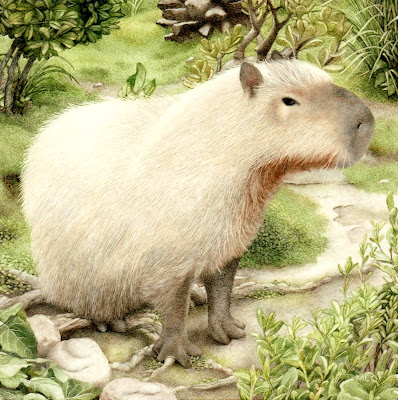Here is my most recent painting:
 Capybara, 4" x 4", watercolor on kaolin clay ground, 2009
Capybara, 4" x 4", watercolor on kaolin clay ground, 2009I have always liked to draw and paint animals, and my pictures usually contain an animal or two, if only in the background. We live not far from an excellent zoo, and the capybara enclosure is always a high point for me. Aside from its being the largest rodent species in the world, the capybara is perhaps not terribly interesting to look at, but its ungainliness and seeming complacency somehow attract me.
Technically speaking, this painting is probably the most painstaking that I have done, given its small size and amount of detail. I recently discovered opaque oxide of chromium, and this painting was, in a way, inspired by that excellent pigment.
7 comments:
Wow the detail! Very beautiful.
Beautiful-very sensitive and gentle.
--Sophie (not a member of guild but look in every once in a while!)
"kaolin clay ground" - is that otherwise known as "Clayboard"? Just wondering - your work is exquisite! (did you have to prepare the board somehow first or just paint right on?)
Yes, it is Claybord. I said kaolin because it sounds more impressive, but also because I recently discovered that it has been used as a ground for some time. I don't prepare the surface in any way, but it is in general necessary to seal the painting after it is complete, which can be tricky...
Michael,
Are you willing to share tips for the sealing step? I assume you seal the watercolor because it might lay more on the Clayboard surface than it does on watercolor paper, making it more vulnerable...? Do you just use a spray varnish or,....?
Lovely! My husband has a bit of a thing for capybaras. The detail is really nice.
First I seal the painting with three coats of Krylon UV-Resistant Clear Gloss spray (recommended to me by Ampersand), and then I give it a coat of Golden MSA varnish with UVLS. This seems to be standard practice with Claybord. (The pigments do lay more on the surface. One could wipe the board clean with a damp sponge if it is not sealed.)
Post a Comment